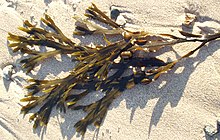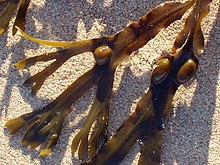Fucus vesiculosus
| Fucus vesiculosus | |
|---|---|

| |
| Scientific classification | |
| Kingdom: | |
| Phylum: | |
| Class: | |
| Order: | |
| Family: | |
| Genus: | |
| Species: | F. vesiculosus
|
| Binomial name | |
| Fucus vesiculosus | |

Fucus vesiculosus, known by the common name bladder wrack or bladderwrack, is a seaweed found on the coasts of the North Sea, the western Baltic Sea, and the Atlantic and Pacific Oceans, also known by the common names black tang, rockweed, bladder fucus, sea oak, black tany, cut weed, dyers fucus, red fucus, and rock wrack. It was the original source of iodine, discovered in 1811, and was used extensively to treat goitre, a swelling of the thyroid gland related to iodine deficiency.
Description
The fronds of F. vesiculosus have a prominent midrib and almost spherical air bladders which are usually paired but may be absent in young plants. The margin is smooth and the frond is dichotomously branched. It is sometimes confused with Fucus spiralis with which it hybridises.[1]
Distribution
Fucus vesiculosus is one of the most common algae on the shores of the British Isles.[2] It has been recorded from the Atlantic shores of Europe, Northern Russia, the Baltic Sea, Greenland, Azores, Canary Islands, Morocco and Madeira.[3][4] It is also found on the Atlantic coast of North America from Ellesmere Island, Hudson Bay to North Carolina.[5]
Ecology
The species is especially common on sheltered shores from the middle littoral to lower intertidal levels.[5] It is rare on exposed shores where any specimens may be short, stunted and without the air vesicles.[6] F. vesiculosus supports few colonial organisms but provides a canopy and shelter for the tube worm Spirorbis spirorbis, herbivorous isopods, such as Idotea and surface grazing snails such as Littorina obtusata.[1] Phlorotannins in Fucus vesiculosus act as chemical defences against the marine herbivorous snail Littorina littorea.[7]
Biology
Plants of F. vesiculosus are dioecious. Gametes are generally released into the seawater under calm conditions and the eggs are fertilised externally to produce a zygote.[1] Eggs are fertilised shortly after being released from the receptacle. A study on the coast of Maine showed that there was 100% fertilisation at both exposed and sheltered sites.[1] Continuously submerged populations in the Baltic Sea are very responsive to turbulent conditions. High fertilisation success is achieved because the gametes are only released when water velocities are low.[8]
Consumption
Primary chemical constituents of this plant include mucilage, algin, mannitol, beta-carotene, zeaxanthin, iodine, bromine, potassium, volatile oils, and many other minerals. The main use of bladder wrack (and other types of seaweed) in herbal medicine is as a source of iodine, an essential nutrient for the thyroid gland. Bladder wrack has been used in the treatment of underactive thyroid glands (hypothyroidism) and goitre.[9]
Bladder wrack has been shown to help women with abnormal menstrual cycling patterns and menstrual-related disease histories.[10] Doses of 700 to 1400 mg/day were found to increase the menstrual cycle lengths, decrease the days of menstruation per cycle, and decrease the serum levels of 17B-estradiol while was later carried out and showed similar effects.[11]
See also
References
- ^ a b c d Marine Life Information Network
- ^ F. G. Hardy & M. D. Guiry (2003). A Check-list and Atlas of the Seaweeds of Britain and Ireland (PDF). London: British Phycological Society. ISBN 0-9527115-1-6.
- ^ M. D. Guiry & Wendy Guiry (January 12, 2007). "Fucus vesiculosus Linnaeus". AlgaeBase. National University of Ireland, Galway. Retrieved April 22, 2012.
- ^ Charlotta A. Nygård & Matthew J. Dring (2008). "Influence of salinity, temperature, dissolved inorganic carbon and nutrient concentration on the photosynthesis and growth of Fucus vesiculosus from the Baltic an Irish Seas". European Journal of Phycology. 43 (3): 253–262. doi:10.1080/09670260802172627.
- ^ a b W. R. Taylor (1957). Marine Algae of the Northeastern Coast of North America. University of Michigan, Ann Arbor. ISBN 0-472-04904-6.
- ^ C. S. Lobban & P. J. Harrison (1994). Seaweed Ecology and Physiology. Cambridge University Press, Cambridge. ISBN 0-521-40897-0.
- ^ J. A. Geiselman & O. J. McConnell (1981). "Polyphenols in brown algae Fucus vesiculosus and Ascophyllum nodosum: chemical defenses against the marine herbivorous snail, Littorina littorea". Journal of Chemical Ecology. 7 (6): 1115–1133. doi:10.1007/BF00987632.
- ^ E. A. Serrao, G. Pearson, L. Kautsky & S. H. Brawley (1996). "Successful external fertilization in turbulent environments". Proceedings of the National Academy of Sciences. 93 (11): 5286–5290. Bibcode:1996PNAS...93.5286S. doi:10.1073/pnas.93.11.5286. PMC 39237. PMID 11607682.
{{cite journal}}: CS1 maint: multiple names: authors list (link) - ^ P. R. Bradley (1992). British Herbal Compendium. Vol. 1. Bournemouth, England: British Herbal Medicine Association. ISBN 0-903032-09-0.
- ^ Christine F. Skibola (2004). "The effect of Fucus vesiculosus, an edible brown seaweed, upon menstrual cycle length and hormonal status in three pre-menopausal women: a case report". BMC Complementary and Alternative Medicine. 4: 10. doi:10.1186/1472-6882-4-10. PMC 514561. PMID 15294021.
{{cite journal}}: CS1 maint: unflagged free DOI (link) - ^ Christine F. Skibola, John D. Curry, Catherine VandeVoort, Alan Conley & Martyn T. Smith (2005). "Brown kelp modulates endocrine hormones in female Sprague–Dawley rats and in human luteinized granulosa cells". Journal of Nutrition. 135 (2): 296–300. PMID 15671230.
{{cite journal}}: CS1 maint: multiple names: authors list (link)
External links
 Media related to Fucus vesiculosus at Wikimedia Commons
Media related to Fucus vesiculosus at Wikimedia Commons- F. Bunker. "Fucus vesiculosus Linnaeus Le Jolis". British Isles Seaweed Images.
- M. D. Guiry. "Fucus vesiculosus Linnaeus". North Atlantic Seaweeds.
- "Bladder wrack (Fucus vesiculosus)". ARKive.
